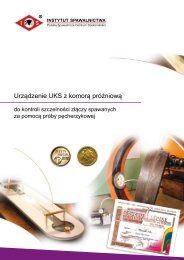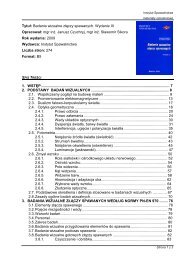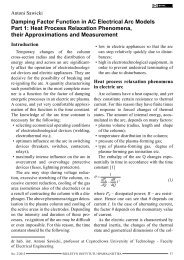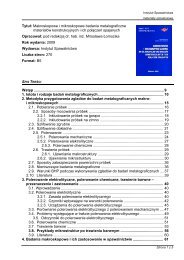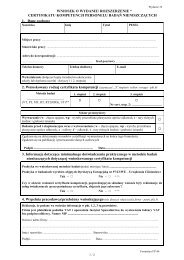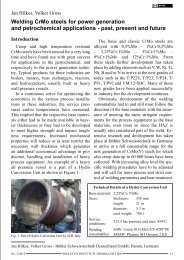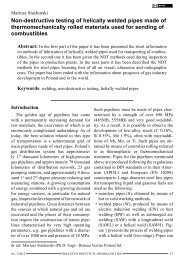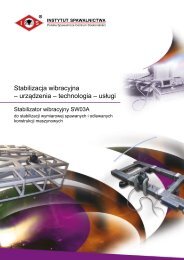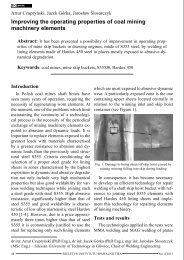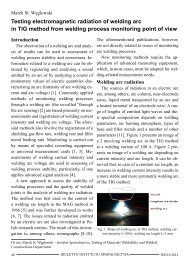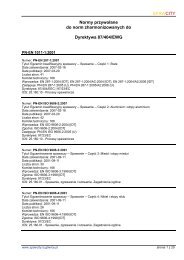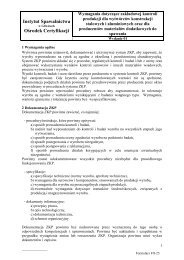Biuletyn Instytutu Spawalnictwa No. 01/2012
Biuletyn Instytutu Spawalnictwa No. 01/2012
Biuletyn Instytutu Spawalnictwa No. 01/2012
You also want an ePaper? Increase the reach of your titles
YUMPU automatically turns print PDFs into web optimized ePapers that Google loves.
The conditions of the selection of models are<br />
as follows:<br />
- Mayr-Kulakov model<br />
In practical considerations [2] one usually<br />
assumes that ϴ (|i|) = const and G min<br />
= 0. Then,<br />
formula (32) can be simplified to<br />
g<br />
2<br />
i dg<br />
1 dg 1 ⎧ u<br />
⎫<br />
koli<br />
ukoli<br />
≈ θ (30) (30) = ⎨[ 1−<br />
ε () i ] + ε () i −1<br />
2<br />
⎬<br />
P dt<br />
g dt θ ⎩ gU<br />
C<br />
PM<br />
⎭<br />
M<br />
M<br />
() t g<br />
M<br />
() t = −<br />
M<br />
, if i < I<br />
0<br />
M<br />
- Cassie-Berger model<br />
with the designation<br />
(34)<br />
g<br />
2<br />
u i dg<br />
⎛ i<br />
≈ θ<br />
2<br />
(31) () (31)<br />
U<br />
C<br />
dt<br />
⎟ ⎞<br />
ε i = exp<br />
⎜ −<br />
(35)<br />
2<br />
⎝ I0<br />
⎠<br />
kol C<br />
C<br />
() t gC () t = −<br />
C<br />
, if i > I0<br />
In welding [10, 11] and furnace [2] arcs, the<br />
value of limiting current I0 is approximately 5<br />
A. In the case of the application of the TWV<br />
model for the approximation of the characteristics<br />
of high-pressure arc lamps, the value of<br />
I0 is almost 10 times lower [12].<br />
The hybrid model of the arc column in the<br />
conductance form is [2]<br />
g<br />
kol<br />
⎡ ⎛ i ⎞⎤<br />
u i ⎡ ⎛ i ⎞⎤<br />
i dgkol<br />
⎢1 ⎜ −<br />
⎢ ⎥<br />
I ⎟⎥<br />
U ⎜ −<br />
C ⎣ I ⎟<br />
(32)<br />
2 2<br />
2<br />
⎣ ⎝ 0 ⎠⎦<br />
⎝ 0 ⎠⎦<br />
PM<br />
dt<br />
2<br />
2 2<br />
() t =<br />
kol<br />
G + − exp⎜<br />
⎟ + exp⎜<br />
⎟ −θ<br />
( i )<br />
min<br />
(32)<br />
where G min<br />
– constant conductance dependent<br />
on the distance between electrodes, their shape<br />
and arrangement as well as on the gas and the<br />
temperature of the environment in currentless<br />
moments; I 0<br />
- transition current between the<br />
Cassie-Berger and Mayr-Kulakov models. In<br />
a general case, the suppression function ϴ depends<br />
on current i<br />
If the current is relatively low, one can assume<br />
that ϴ≈ϴ 1<br />
, and when current is high one<br />
can assume that ϴ≈ϴ 0<br />
. If ϴ→0, the static characteristic<br />
results from adopted assumptions<br />
related to the participation of individual constituent<br />
models:<br />
• if │i│ < I 0<br />
and dg/dt = 0, then u = P M<br />
/i;<br />
• if │i│ > I 0<br />
and dg/dt = 0, then u = U C<br />
sign(i).<br />
The creation of the resistance form of the<br />
hybrid model, analogous to the conductance<br />
TWV, is difficult for computer recording and<br />
implementation. For this reason, the resistance<br />
form is not subject to consideration.<br />
The TWV model is successfully used in simulations<br />
of stationary processes in welding<br />
and electrothermal devices as well as in systems<br />
with discharge light sources [2, 10-12].<br />
If here, like previously, one introduces the<br />
Mayr-Kulakov model, taking into consideration<br />
the virtual static characteristic of the arc<br />
component Ustat(iM), instead of (34) one receives<br />
At time intervals when current |i| values are<br />
low, the Mayr-Kulakov conductance constituent<br />
plays an important role and the dependence<br />
i<br />
(33) M<br />
≈i takes place. Thus, one can approximately<br />
0<br />
+ θ1<br />
( −α i )<br />
(33)<br />
write that U stat<br />
(i M<br />
) = U stat<br />
(i) and then<br />
θ = θ exp<br />
1<br />
g<br />
1<br />
g<br />
dg<br />
dt<br />
dg<br />
dt<br />
1 ⎧ ukoli<br />
ukoli<br />
= ⎨[ 1−ε<br />
() i ] + ε () i<br />
−1<br />
2<br />
θ ⎩ gU<br />
C<br />
iM<br />
⋅U<br />
stat M<br />
1 ⎧ ukoli<br />
ukol<br />
= ⎨[ 1−ε<br />
() i ] + ε () i −1<br />
2<br />
θ ⎩ gU U () i ⎭ ⎬⎫<br />
C<br />
stat<br />
( i ) ⎭ ⎬⎫<br />
(36)<br />
(37)<br />
Representation of the disturbance of<br />
arc column length with modified Cassie-Berger<br />
and Mayr-Kulakov<br />
An increase in the geometric size of the plasma<br />
arc column is accompanied by an increase<br />
in energy necessary to generate an additional<br />
NR <strong>01</strong>/2<strong>01</strong>2<br />
BIULETYN INSTYTUTU SPAWALNICTWA<br />
19



